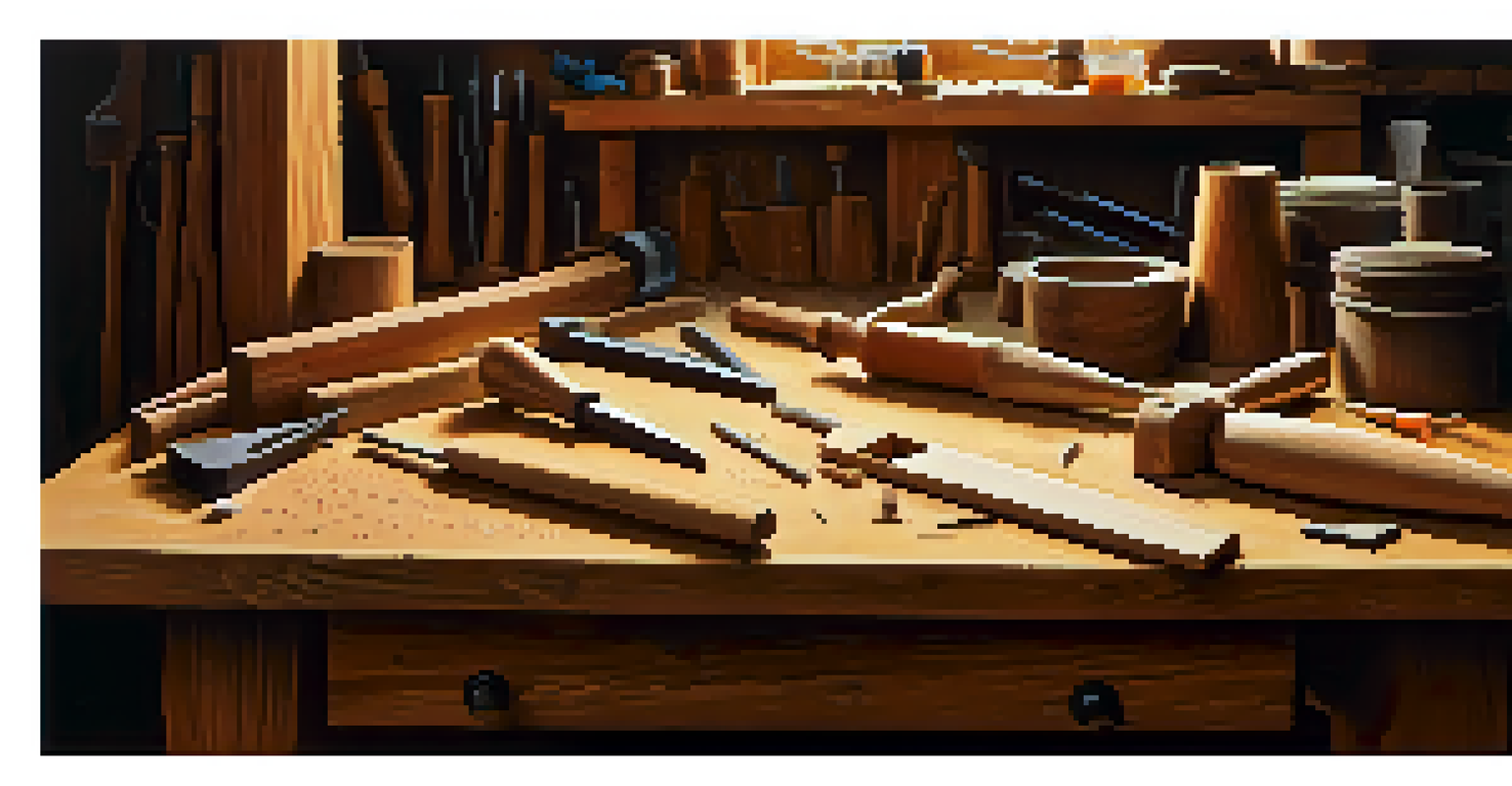From Wood to Stone: Carving Materials and Expression

The Timeless Allure of Wood in Carving
Wood has been a cherished material for carving for centuries, prized for its warmth and versatility. Artists often choose wood for its natural beauty and ease of manipulation, allowing for intricate designs and detailed textures. The unique grains and colors of different types of wood, such as oak or walnut, add character to each piece, making every carving a one-of-a-kind creation.
Wood is the most humanly intimate of all materials.
Imagine the feeling of a freshly carved wooden figure, the smoothness of the surface under your fingertips, and the scent of the wood filling the air. Wood carving is not just about creating art; it’s about connecting with nature and honoring the material's inherent qualities. This tactile experience is often what draws both novice and master carvers to wood as their primary medium.
Moreover, wood carving has a rich tradition across various cultures, from totem poles in Indigenous communities to intricate sculptures in European history. Each culture brings its own techniques and styles, enriching the global tapestry of wood artistry. This blend of history, technique, and personal expression makes wood an enduring choice for artists.
The Rise of Stone as a Carving Medium
Stone carving, often associated with monumental sculptures, has a majestic quality that captivates artists and viewers alike. The durability and solidity of stone make it an ideal medium for creating lasting works of art that can withstand the test of time. From ancient Greek statues to modern abstract forms, stone offers a unique aesthetic that wood simply cannot replicate.

Working with stone is a meticulous process that requires patience and skill. Unlike wood, stone is unforgiving; a single mistake can lead to irreversible damage. However, this challenge is what draws many artists to stone carving, as the end result often reflects the artist's resilience and dedication. The transformation of a rough block into a polished masterpiece is a journey of discovery and expression.
Wood: A Tactile Tradition
Wood carving offers a unique connection to nature, allowing artists to create intricate designs while honoring the material's natural beauty.
Additionally, the variety of stones available, such as marble, granite, and limestone, each brings its own characteristics to a carving. The colors, textures, and hardness of these materials influence the techniques and tools used, allowing for a diverse range of artistic expressions. This versatility is what makes stone carving a fascinating field for artists seeking to push their creative boundaries.
Tools of the Trade: Carving Instruments Explained
Whether working with wood or stone, the tools used in carving play a crucial role in the creative process. For wood, chisels, gouges, and knives are common, each designed for specific cuts and details. These tools allow artists to shape their vision with precision, turning rough lumber into delicate forms that tell a story.
Sculpture is the art of the intelligence.
In stone carving, however, the toolset shifts to include hammers, chisels, and pneumatic tools, which are essential for breaking down harder materials. Understanding the right tool for the job is key; for instance, a pointed chisel is perfect for detail work, while a flat chisel is ideal for broader areas. This knowledge empowers artists to approach their projects confidently, knowing they have the right instruments at their disposal.
Both mediums also require proper safety equipment, such as goggles and gloves, ensuring a safe working environment. The artistry in carving is not just about vision and technique; it also involves respecting the materials and tools that bring a piece to life. This blend of artistry and craftsmanship is what makes carving a truly rewarding pursuit.
Techniques: Sculpting Wood and Stone
Carving techniques vary significantly between wood and stone, influenced by the characteristics of each medium. In wood carving, techniques like whittling, relief carving, and chip carving allow for a range of textures and designs. These methods enable artists to create everything from intricate patterns to simple figures, showcasing the material's natural beauty.
Stone carving techniques, on the other hand, often involve subtractive methods, where material is removed to reveal the desired shape. Techniques such as point work, roughing out, and polishing require different skills and tools, challenging artists to adapt their approach. The tactile feedback from stone also offers a unique experience, as artists can feel the material respond to their touch.
Stone: Timeless Strength
Stone carving embodies durability and permanence, with artists facing unique challenges that transform rough materials into lasting masterpieces.
Both mediums encourage experimentation, allowing artists to develop their own styles and techniques over time. The journey of mastering these methods is a personal one, filled with triumphs and challenges. Ultimately, whether working with wood or stone, the techniques employed become an integral part of the artistic expression.
Cultural Significance of Carving Materials
Throughout history, different cultures have adopted specific carving materials that reflect their values and resources. For instance, in many Indigenous cultures, wood carving is not only an art form but also a way to preserve stories and traditions. Totem poles, masks, and other wooden artifacts often carry deep spiritual significance, serving as a connection to ancestral heritage.
Conversely, stone carving has been utilized by civilizations like the Egyptians and Greeks to create monumental works that celebrate their achievements and beliefs. The use of stone for temples, statues, and memorials signifies a desire for permanence and grandeur. These cultural artifacts tell stories that transcend time, linking past and present.
Today, the choice of carving material continues to hold cultural weight, influencing how art is created and perceived around the world. Artists draw upon these traditions while infusing their unique perspectives, creating a dynamic dialogue between past and present. Understanding the cultural implications of carving materials enriches our appreciation for the art and the stories behind it.
Emotional Expression in Carving: Wood vs. Stone
The emotional expression conveyed through carving can vary greatly depending on the material used. Wood often evokes feelings of warmth and intimacy, as its natural grains and colors can suggest softness and approachability. Artists may find that working with wood allows them to explore more playful and organic forms, reflecting a sense of comfort and connection.
In contrast, stone carries a sense of permanence and strength, often associated with grandeur and resilience. The cold, hard surfaces can express feelings of solemnity or power, making it a choice for artists looking to convey deeper, more profound themes. This stark difference in emotional resonance reveals how the choice of material can shape the narrative of a piece.
Evolving Techniques and Sustainability
The future of carving blends traditional methods with digital innovations, while also emphasizing sustainable practices in material sourcing.
Ultimately, the emotional impact of a carving is a reflection of the artist's intentions and the qualities of the material itself. Both wood and stone offer unique avenues for expression, allowing artists to communicate their visions in ways that resonate with viewers. This interplay between material and emotion is what makes carving such a powerful art form.
The Future of Carving: Innovations and Trends
As we move further into the 21st century, the world of carving is evolving alongside technological advancements. Artists are beginning to incorporate digital tools and techniques into their workflows, blending traditional methods with modern technology. This fusion opens up new possibilities for creativity, allowing for intricate designs that may have been impossible to achieve by hand alone.
However, the charm of traditional carving remains strong, with many artists still valuing the tactile experience of working with wood and stone. Workshops and classes dedicated to these age-old techniques continue to thrive, fostering a community that appreciates the craftsmanship involved. The future of carving seems to lie in this balance between innovation and tradition.

Moreover, sustainability is becoming a major consideration in the choice of materials. Artists are increasingly seeking out reclaimed wood and ethically sourced stone, promoting environmental consciousness within the craft. This trend not only reflects a growing awareness of ecological issues but also adds depth to the artistry, as the materials themselves carry stories of renewal and responsibility.